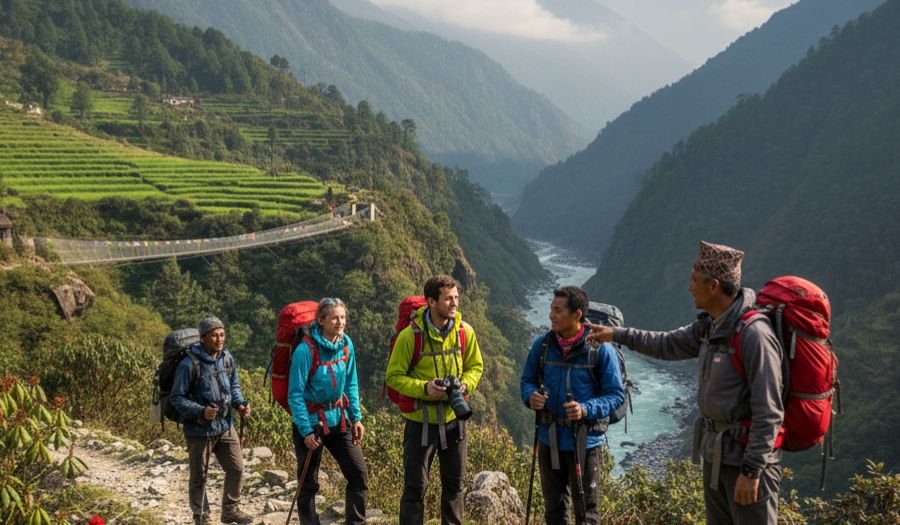Hidden Treks in Nepal That Also Give Back to Local Villages


When people think of trekking in Nepal, the names Everest Base Camp and Annapurna Circuit often come first. But beyond these world-famous routes lies a different side of the Himalayas—quieter, greener, and deeply connected to the people who call these mountains home.
Welcome to the world of community-based trekking—a sustainable and meaningful way to explore Nepal. These trails take you off the beaten path and directly support local communities. Every meal, homestay, and guide you choose contributes to village development, education, and cultural preservation.
If you’re looking for hidden treks in Nepal where your adventure gives back, this guide is for you.
What Is Community-Based Trekking?
Community-based trekking means traveling responsibly while ensuring that the money you spend stays in the community. You stay in village-run guesthouses, eat locally grown food, and engage with families who open their homes to travelers.
Unlike commercial treks, this form of tourism promotes sustainability, fair income, and cultural exchange. It’s adventure with purpose—where you don’t just trek for views, but also for values.
Why Choose Hidden Treks Over Popular Routes?
While the classic routes of Nepal are iconic, lesser-known treks offer something truly special:
- Peace and authenticity: fewer crowds and a closer look at rural life.
- Environmental protection: Smaller groups mean less ecological impact.
- Cultural richness: You witness traditional songs, crafts, and rituals.
- Meaningful travel: Your spending supports community schools and local cooperatives.
In short, off-the-beaten-path trekking in Nepal gives you both adventure and impact.
Top 5 Hidden Treks in Nepal That Support Local Communities
-
Mohare Danda Community Trek (Myagdi District)
Duration: 5–7 days | Difficulty: Moderate
Known as Nepal’s first community eco-lodge trek, Mohare Danda offers a peaceful route between the Dhaulagiri and Annapurna ranges. The trail passes through Magar and Gurung villages like Banskharka and Nangi, where locals run sustainable lodges.
Your stay directly funds education and renewable energy projects in these mountain communities. The panoramic sunrise from Mohare Danda rivals Poon Hill—without the crowds.
Travel tip: Visit Mohare Danda Eco-Lodge, which operates on solar energy and promotes zero-waste trekking.

-
Chepang Hill Trek (Chitwan Region)
Duration: 4–6 days | Difficulty: Moderate
Explore the hills of the indigenous Chepang community, one of Nepal’s lesser-known ethnic groups. Their trail winds through terraced farms and forested ridges with community homestays along the way.
You’ll taste homemade millet beer, join evening folk songs, and experience life close to nature.
Impact: Trekking here empowers the Chepang people through tourism while helping preserve their language and heritage.
-
Ruby Valley Trek (Between Langtang and Manaslu)
Duration: 7–10 days | Difficulty: Moderate–Challenging
The hidden gem between Langtang and Manaslu regions, the Ruby Valley Trek is perfect for those who want to experience raw wilderness and authentic Tamang and Gurung culture.
Community-based lodges were built after the 2015 earthquake, helping locals rebuild their lives through tourism income. Expect natural hot springs, mountain vistas, and real hospitality.
Why go: Your visit helps fund reconstruction and local education projects.

-
Khopra Ridge Community Trek (Annapurna Region)
Duration: 6–9 days | Difficulty: Moderate
Branching off from the crowded Ghorepani route, Khopra Ridge offers a peaceful trail lined with rhododendrons and yak pastures. The community-managed Khopra Lodge reinvests profits into healthcare and school projects.
You can also trek to Khayar Lake, a sacred alpine site few outsiders reach.
Highlight: One of the best off-the-beaten-path treks in Nepal with 360° Himalayan views.
-
Lower Dolpo Cultural Circuit
Duration: 10–14 days | Difficulty: Challenging
For a truly remote adventure, head west to Lower Dolpo—where Tibetan culture, ancient monasteries, and turquoise lakes await.
Local cooperatives manage trekking permits and community lodges, ensuring tourism supports yak herders and monastery conservation.
Good to know: Dolpo requires a special permit but rewards you with unmatched peace and authenticity.
How Community Trekking Benefits Nepal
Choosing community-based treks in Nepal means:
- Empowering rural economies
- Preserving traditional culture and craftsmanship
- Promoting eco-friendly travel
- Supporting education and healthcare initiatives
- Reducing migration from mountain villages by providing local income
It’s proof that travel can heal—both for the traveler and the community.
Planning Your Sustainable Trek
If you are inspired to trek responsibly, here are some practical tips:
- Hire local guides and book with community-based agencies.
- Use refillable bottles and avoid single-use plastics.
- Stay in homestays instead of large lodges.
- Respect local customs—a little Nepali greeting (“Namaste”) goes a long way.
- Share your experience online to inspire more responsible travelers.
Final Thoughts
Nepal’s greatest beauty lies not only in its peaks but also in the people who live beneath them. By choosing hidden treks that give back , you walk through landscapes that change lives—including your own.
So, lace up your boots, take the road less traveled, and let your trek become a story of sustainability, connection, and gratitude.
Go trekking. Give Back. Grow Together.







